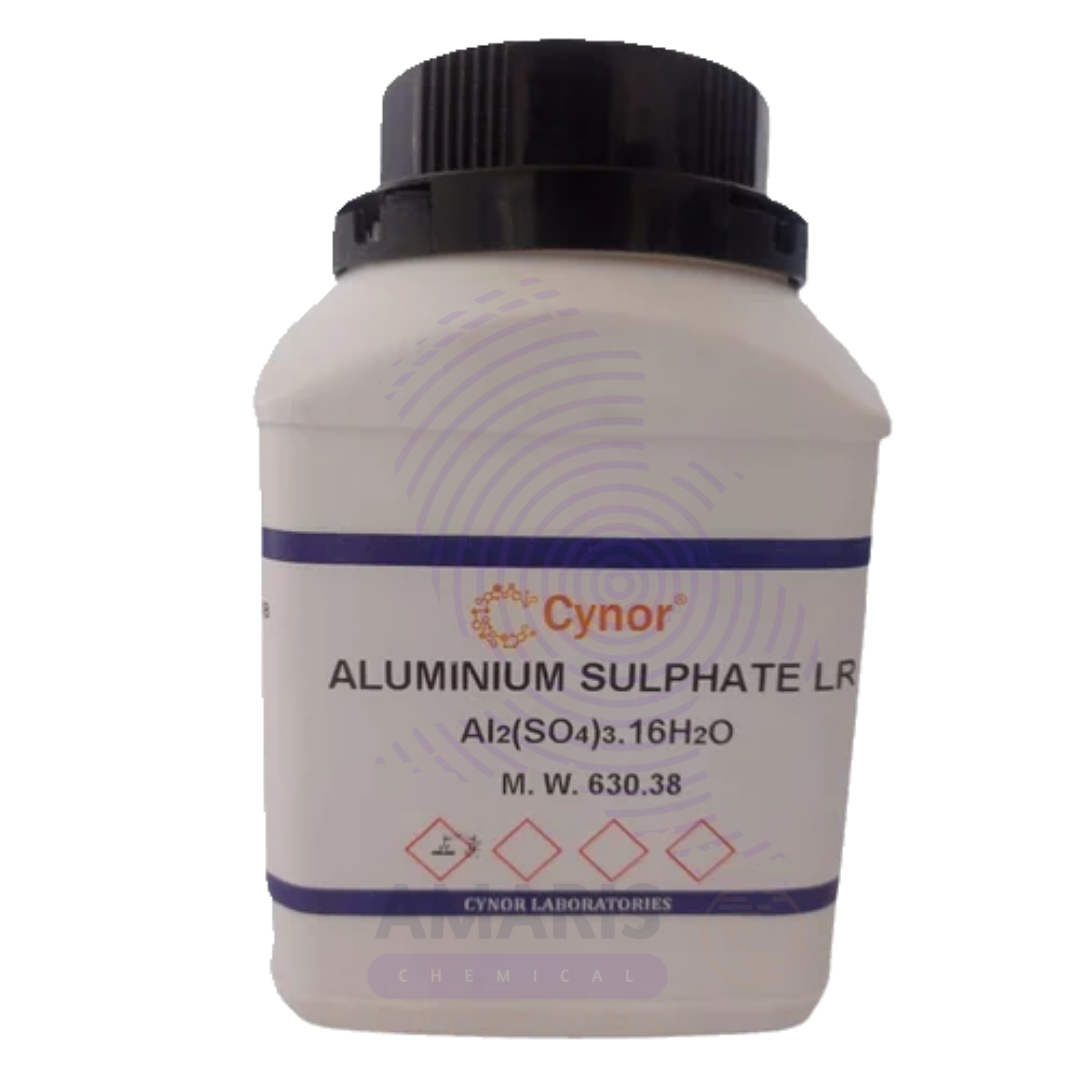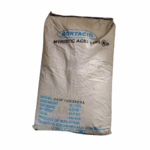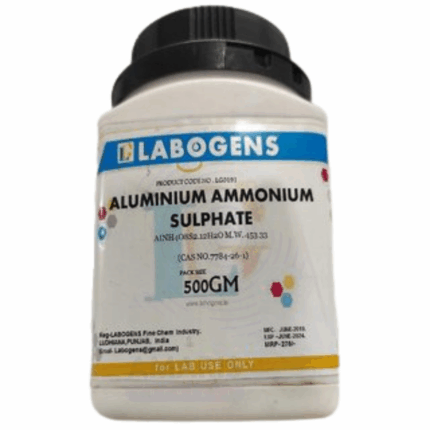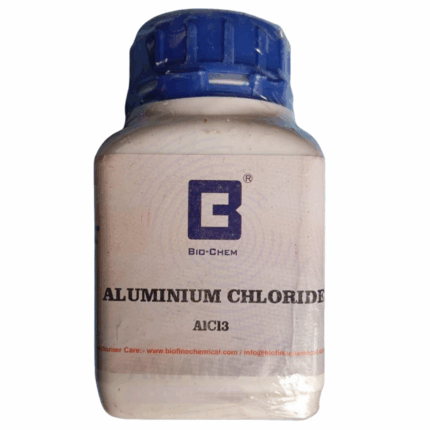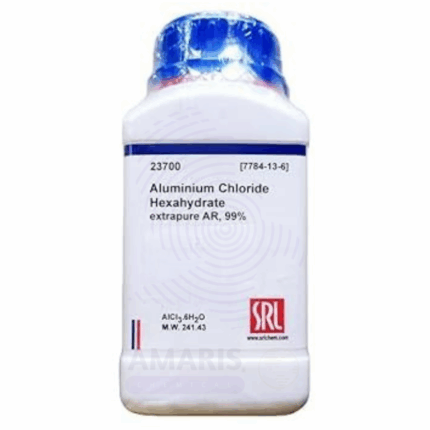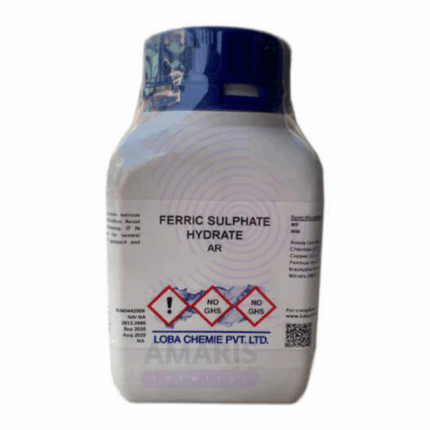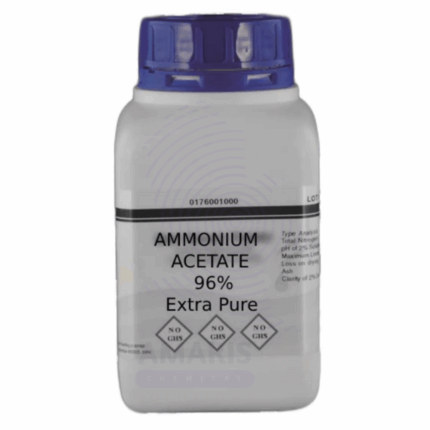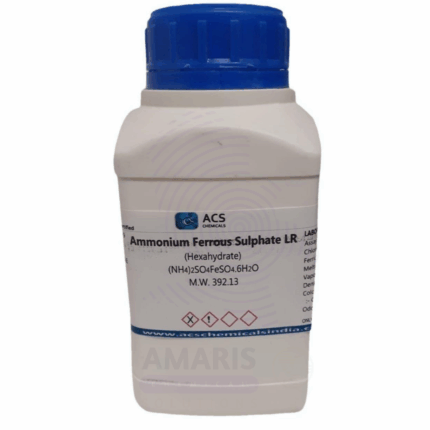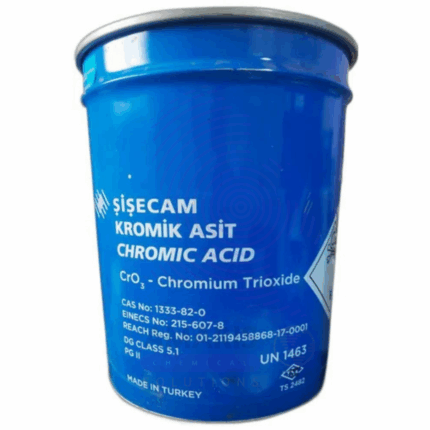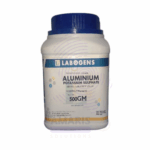
Aluminium Sulphate Anhydrous Extra Pure
$ 18.00 Original price was: $ 18.00.$ 17.84Current price is: $ 17.84.
Aluminium Sulphate Anhydrous Extra Pure is a high-purity, white crystalline or powdery solid commonly used in laboratory chemistry as a source of aluminum ions for precipitation, titration, and coordination studies. Its anhydrous form provides a concentrated and stable option for applications requiring precise control over water content, such as analytical reagent preparation, pH adjustment, and synthesis of other aluminum salts. This compound is also used in paper sizing experiments, dye fixation, and water treatment research. The extra pure grade ensures very low levels of contaminants, supporting accurate and reproducible results in sensitive experimental work. It should be stored in airtight containers in a dry area to prevent moisture absorption and preserve its chemical integrity.
Aluminium Sulphate Anhydrous Extra Pure
Primary Uses
- Reagent in Analytical Chemistry
- Supplies aluminum ions for precipitation, complexation, and qualitative group analysis.
- Coagulant in Water Treatment Simulation Studies
- Used in lab-scale flocculation/coagulation experiments modeling industrial water and wastewater treatment.
- Synthesis of Other Aluminium Compounds
- Acts as a precursor to prepare aluminum hydroxide, alumina, and double salts like alums.
- Study of Hydrolysis and pH Changes
- Demonstrates acidic salt hydrolysis and pH-lowering behavior when dissolved in water, ideal for acid-base equilibrium studies.
- Educational Demonstrations in Salt Chemistry
- Common in labs illustrating double salt reactions, solubility, and ionic dissociation.
Secondary Uses
- Ionic Strength Control in Solutions
- Used in buffer and solution preparation to adjust ionic strength for electrochemical or biological experiments.
- Catalysis Research (Precursor Form)
- Serves as a starting material for the preparation of alumina-supported catalysts or other aluminum-based catalysts.
- Simulation of Acid Mine Drainage
- Studied in environmental chemistry labs to model the mobility of metals in acidic, sulfate-rich waters.
- Soil and Plant Chemistry Experiments
- Investigated for its effects on pH, nutrient availability, and aluminum toxicity in lab-based agronomic studies.
- Thermal Decomposition Studies
- Studied in solid-state chemistry for breakdown into alumina and sulfur oxides under heating.
| PACK SIZE |
500 grams Plastic Tin |
|---|
1. Basic Identification Attributes
- Chemical Name: Aluminium Sulphate (Anhydrous)
- CAS Number: 10043-01-3
- HS Code: 28332200 (Aluminium sulphate)
- Molecular Formula: Al₂(SO₄)₃
- Synonyms:
- Anhydrous aluminium sulfate
- Dialuminium trisulfate
- Aluminum sulphate
- Cake alum (when hydrated)
- Al₂(SO₄)₃
2. Physical & Chemical Properties
- Physical State: Solid (powder or granules)
- Color & Odor: White to gray powder; odorless
- Boiling Point: Decomposes before boiling
- Melting Point: ~770°C (decomposes)
- Density/Specific Gravity: ~2.71 g/cm³
- Solubility:
- Water: Soluble (highly exothermic dissolution)
- Alcohol: Insoluble
- pH Level: ~2.0–3.0 in 5% aqueous solution
- Vapor Pressure: Negligible
- Flash Point: Not flammable
- Autoignition Temperature: Not applicable
- Viscosity: Not applicable (solid)
3. Safety & Hazard Attributes
- Hazard Class (GHS):
- Skin/Eye Irritation (Category 2)
- May cause respiratory irritation (dust)
- NFPA Ratings:
- Health: 2
- Flammability: 0
- Reactivity: 0
- Exposure Limits:
- OSHA PEL: Not established for compound
- Use nuisance dust limits (15 mg/m³ total, 5 mg/m³ respirable)
- Reactivity:
- Reacts with water, releasing heat
- Reacts with bases to form aluminium hydroxide
4. Storage & Handling Attributes
- Storage Conditions:
- Store in cool, dry, and well-ventilated area
- Keep container tightly sealed to prevent moisture uptake
- Incompatible Materials:
- Strong bases, reducing agents, reactive metals
- Container Type:
- HDPE, glass, or lined fiber containers
- Shelf Life & Expiration Date:
- ~2–3 years if kept dry and sealed
- Special Handling Requirements:
- Use gloves, goggles, and dust mask
- Avoid breathing dust or direct skin contact
5. Regulatory & Compliance Attributes
- Regulatory Status:
- Listed under TSCA, REACH
- Common reagent in analytical and environmental laboratories
- Transportation Restrictions:
- Not classified as hazardous for transport
- Waste Disposal Method:
- Dilute and neutralize before disposal
- Follow local and institutional guidelines for non-hazardous inorganic waste
6. Environmental & Health Impact
- Ecotoxicity:
- May cause harm to aquatic life in concentrated form
- Contributes to water acidity if released in large amounts
- Persistence in Environment:
- Dissociates in water to sulfate and aluminium ions
- Carcinogenicity/Mutagenicity:
- Not classified as carcinogenic or mutagenic
- Biodegradability:
- Inorganic; not biodegradable but chemically manageable
SAFETY PRECAUTIONS
- Personal Protective Equipment (PPE):
- Wear a lab coat, chemical-resistant gloves (e.g., nitrile), and safety goggles.
- Use a dust mask or respirator if dust formation is likely.
- Handling:
- Avoid generating dust and inhaling airborne particles.
- Prevent contact with eyes, skin, and clothing.
- Use in a well-ventilated lab or under a chemical fume hood.
- Avoid contact with strong bases (may release heat and cause splattering).
- Storage:
- Store in a tightly sealed, labeled container in a cool, dry, and well-ventilated area.
- Keep away from moisture and incompatible materials such as alkalis and reactive metals.
- Protect from physical damage and humidity.
- Hygiene Measures:
- Wash hands thoroughly after handling.
- Avoid touching face or eyes during use.
- Do not eat, drink, or smoke in the lab.
FIRST AID MEASURES
- Inhalation:
- Move to fresh air immediately.
- Rinse mouth and nose with water if dust was inhaled.
- Seek medical attention if respiratory symptoms develop.
- Skin Contact:
- Wash skin thoroughly with soap and water.
- Remove contaminated clothing.
- Seek medical attention if redness, irritation, or burning occurs.
- Eye Contact:
- Immediately flush eyes with water for at least 15 minutes.
- Hold eyelids open during rinsing.
- Seek immediate medical attention if irritation persists.
- Ingestion:
- Rinse mouth with water.
- Do not induce vomiting.
- Give water or milk to dilute only if the person is fully conscious.
- Seek immediate medical attention, as ingestion may irritate or damage the digestive tract.
FIRE FIGHTING MEASURES
- Suitable Extinguishing Media:
- Use dry chemical, water spray, carbon dioxide (CO₂), or foam suitable for surrounding materials.
- Specific Hazards:
- Non-combustible, but may decompose at high temperatures, releasing sulfur oxides and aluminum oxide.
- May contribute to acidic or corrosive runoff during a fire.
- Protective Equipment for Firefighters:
- Use self-contained breathing apparatus (SCBA) and full chemical protective gear.
- Firefighting Instructions:
- Isolate area and control runoff.
- Cool containers with water spray to prevent rupture from heat.
- Avoid inhalation of fumes or dust during and after fire.


 Preservatives(food)
Preservatives(food) Flavor Enhancers
Flavor Enhancers Acidulants
Acidulants Sweeteners
Sweeteners Antioxidants
Antioxidants Colorants(food)
Colorants(food) Nutraceutical Ingredients (food)
Nutraceutical Ingredients (food) Nutrient Supplements
Nutrient Supplements Emulsifiers
Emulsifiers
 Collectors
Collectors Dust Suppressants
Dust Suppressants Explosives and Blasting Agents
Explosives and Blasting Agents Flocculants and Coagulants
Flocculants and Coagulants Frothers
Frothers Leaching Agents
Leaching Agents pH Modifiers
pH Modifiers Precious Metal Extraction Agents
Precious Metal Extraction Agents
 Antioxidants(plastic)
Antioxidants(plastic) Colorants (Pigments, Dyes)
Colorants (Pigments, Dyes) Fillers and Reinforcements
Fillers and Reinforcements Flame Retardants
Flame Retardants Monomers
Monomers Plasticizers
Plasticizers Polymerization Initiators
Polymerization Initiators Stabilizers (UV, Heat)
Stabilizers (UV, Heat)
 Antifoaming Agents
Antifoaming Agents Chelating Agents
Chelating Agents Coagulants and Flocculants
Coagulants and Flocculants Corrosion Inhibitors
Corrosion Inhibitors Disinfectants and Biocides
Disinfectants and Biocides Oxidizing Agents
Oxidizing Agents pH Adjusters
pH Adjusters Scale Inhibitors( water)
Scale Inhibitors( water)
 Antioxidants(cosmetic)
Antioxidants(cosmetic) Emollients
Emollients Fragrances and Essential Oils
Fragrances and Essential Oils Humectants
Humectants Preservatives
Preservatives Surfactants(cosmetic)
Surfactants(cosmetic) Thickeners
Thickeners UV Filters
UV Filters
 Fertilizers
Fertilizers Soil Conditioners
Soil Conditioners Plant Growth Regulators
Plant Growth Regulators Animal Feed Additives
Animal Feed Additives Biostimulants
Biostimulants Pesticides (Herbicides, Insecticides, Fungicides)
Pesticides (Herbicides, Insecticides, Fungicides)
 Active Pharmaceutical Ingredients (APIs)
Active Pharmaceutical Ingredients (APIs) Excipients
Excipients Solvents(pharmaceutical)
Solvents(pharmaceutical) Antibiotics
Antibiotics Antiseptics and Disinfectants
Antiseptics and Disinfectants Vaccine Adjuvants
Vaccine Adjuvants Nutraceutical Ingredients (pharmaceutical)
Nutraceutical Ingredients (pharmaceutical) Analgesics & Antipyretics
Analgesics & Antipyretics
 Analytical Reagents
Analytical Reagents Solvents(lab)
Solvents(lab) Chromatography Chemicals
Chromatography Chemicals Spectroscopy Reagents
Spectroscopy Reagents microbiology-and-cell-culture-reagents
microbiology-and-cell-culture-reagents Molecular Biology Reagents
Molecular Biology Reagents Biochemical Reagents
Biochemical Reagents Inorganic and Organic Standards
Inorganic and Organic Standards Laboratory Safety Chemicals
Laboratory Safety Chemicals Specialty Laboratory Chemicals(Special Laboratory Equipment)
Specialty Laboratory Chemicals(Special Laboratory Equipment)
 Demulsifiers
Demulsifiers Hydraulic Fracturing Fluids
Hydraulic Fracturing Fluids Scale Inhibitors(oil)
Scale Inhibitors(oil) Surfactants(oil)
Surfactants(oil) Drilling Fluids
Drilling Fluids
 Dyes and Pigments
Dyes and Pigments Bleaching Agents
Bleaching Agents Softening Agents
Softening Agents Finishing Agents
Finishing Agents Antistatic Agents
Antistatic Agents
 Admixtures
Admixtures Waterproofing Agents
Waterproofing Agents Sealants and Adhesives
Sealants and Adhesives Curing Compounds
Curing Compounds Concrete Repair Chemicals
Concrete Repair Chemicals Anti-Corrosion Coatings
Anti-Corrosion Coatings
 Surfactants(cleaning)
Surfactants(cleaning) Builders
Builders Enzymes
Enzymes Solvents (Cleaning)
Solvents (Cleaning) Fragrances
Fragrances
 Electronic Chemicals
Electronic Chemicals Catalysts
Catalysts Lubricants
Lubricants Photographic Chemicals
Photographic Chemicals Refrigerants
Refrigerants Automotive chemicals
Automotive chemicals Pyrotechnic Chemicals
Pyrotechnic Chemicals
 Biodegradable Surfactants
Biodegradable Surfactants Bio-based Solvents
Bio-based Solvents Renewable Polymers
Renewable Polymers Carbon Capture Chemicals
Carbon Capture Chemicals Wastewater Treatment Chemicals
Wastewater Treatment Chemicals
 Pigments
Pigments Solvents(paint)
Solvents(paint) Specialty Coatings
Specialty Coatings Binders/Resins
Binders/Resins Additives
Additives Driers
Driers Anti-Corrosion Agents
Anti-Corrosion Agents Functional Coatings
Functional Coatings Application-Specific Coatings
Application-Specific Coatings
 Fresh Herbs
Fresh Herbs Ground Spices
Ground Spices Whole Spices
Whole Spices Spice Blends
Spice Blends Dried Herbs
Dried Herbs
 Leavening Agents
Leavening Agents Dough Conditioners
Dough Conditioners Flour Treatments
Flour Treatments Fat Replacers
Fat Replacers Decoratives
Decoratives Preservatives(baking)
Preservatives(baking)
 Plasticizers & Softeners
Plasticizers & Softeners Reinforcing Agents
Reinforcing Agents Adhesion Promoters
Adhesion Promoters Vulcanizing Agents
Vulcanizing Agents Antidegradants
Antidegradants Blowing Agents
Blowing Agents Fillers & Extenders
Fillers & Extenders Accelerators & Retarders
Accelerators & Retarders